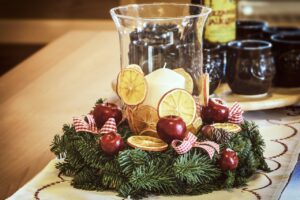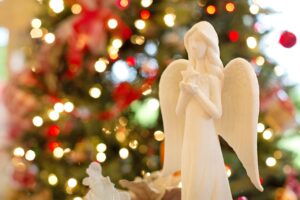 It’s the time of year for parties, food, and gifts galore! None of this relates to the original nativity… or does it? While we may go overboard, might we actually have the basics down for celebrating Christ’s birth?
It’s the time of year for parties, food, and gifts galore! None of this relates to the original nativity… or does it? While we may go overboard, might we actually have the basics down for celebrating Christ’s birth?
In the Old Testament, God established feasts, basically commanding the Jews to hold seven annual parties—many of which involved food and gifts! Each feast represented something significant God had done for His chosen people. At every feast they remembered God’s faithfulness. And each feast foreshadows Christ.
 Passover – This first festival of the Jewish calendar recalls how the angel of death passed over the homes of those who applied the blood of a spotless lamb to their doors. In John 1:29, John the Baptist called Christ, “the Lamb of God who takes away the sin of the world!” His blood bought our salvation.
Passover – This first festival of the Jewish calendar recalls how the angel of death passed over the homes of those who applied the blood of a spotless lamb to their doors. In John 1:29, John the Baptist called Christ, “the Lamb of God who takes away the sin of the world!” His blood bought our salvation.
Unleavened bread – At this festival, the children of Israel remembered how God delivered them from slavery and freed them from captivity. They ate unleavened bread in their haste to leave Egypt. Leaven depicts sin, and Jesus is our sinless Savior, the bread of life (John 6:35).
First Fruits – During this first harvest festival they thanked God for all He had provided. They celebrated it on the “third day” after Passover—the same day Jesus was later resurrected. In 1 Corinthians 15:20, Paul calls Jesus, the first fruits of the dead—the first of many who would resurrect to eternal life through His blood.
Pentecost – This is the second of the three harvest feasts. The Jews were told to bring the first harvest of grain as a gift to the Lord, including two leavened loaves of bread. Those loaves represent Jews and Gentiles, people from all over the world who make up Christ’s church—which was “born” at Pentecost (Acts 1).
 Trumpets – During this feast God commanded the Jews to rest and to bring food offerings. The sound of a trumpet is often associated with the moment Christ will return for his bride (1 Corinthians 15:52). Once he returns, there will be a wedding feast of celebration!
Trumpets – During this feast God commanded the Jews to rest and to bring food offerings. The sound of a trumpet is often associated with the moment Christ will return for his bride (1 Corinthians 15:52). Once he returns, there will be a wedding feast of celebration!
Day of Atonement – This was a day of humility and repentance to God. A bull and a goat were offered in thanksgiving, but the scapegoat symbolically took away their sins for that year. 1 John 2:2 reveals that, He himself (Jesus) is the sacrifice that atones for our sins—and not only our sins but the sins of all the world.
 Tabernacles – This final celebration followed the solemn Day of Atonement, once again celebrating God’s provision. During their forty years wandering in the wilderness after fleeing Egypt, The Lord himself traveled with the Israelites in a giant portable tent called the tabernacle. This feast declares how He tabernacled, or dwelt, with His people. And a few months before Christ’s birth an angel appeared to Joseph in a dream, saying, “Behold, the virgin (Mary) will conceive and give birth to a Son, and they shall name Him Immanuel,” which translated means, “God with us” (Matthew 1:23).
Tabernacles – This final celebration followed the solemn Day of Atonement, once again celebrating God’s provision. During their forty years wandering in the wilderness after fleeing Egypt, The Lord himself traveled with the Israelites in a giant portable tent called the tabernacle. This feast declares how He tabernacled, or dwelt, with His people. And a few months before Christ’s birth an angel appeared to Joseph in a dream, saying, “Behold, the virgin (Mary) will conceive and give birth to a Son, and they shall name Him Immanuel,” which translated means, “God with us” (Matthew 1:23).
 Parties, food, and gifts seem to be the trifecta of celebrations in God’s book. And for thousands of years He ordained festivals hinting of Christ’s birth. It looks to me as if He’s been preparing us to celebrate all along!
Parties, food, and gifts seem to be the trifecta of celebrations in God’s book. And for thousands of years He ordained festivals hinting of Christ’s birth. It looks to me as if He’s been preparing us to celebrate all along!


Have a very merry Christmas!